Group Report: HRM Analysis of Safety Culture at Evans Smallgoods
VerifiedAdded on 2022/09/10
|21
|4903
|16
Report
AI Summary
This report analyzes the safety culture within Evans Smallgoods, a major supplier in the Australian smallgoods market, focusing on the company's HRM practices and safety protocols. It begins by outlining the legal responsibilities of employers in ensuring a safe work environment, followed by a definition of safety culture and its significance in the food and beverage industry. The report then explores the importance of managerial commitment, visible administration, effective communication, and inspection processes in fostering a positive safety culture. It also discusses the impact of safety culture on quality, reliability, competitiveness, and profitability. The report provides recommendations to improve the existing safety culture, including human resource management strategies, training and development programs, a consumer-focused approach, effective communication, and regular safety assessments. The report concludes by summarizing the key findings and emphasizing the need for a robust safety culture to enhance employee safety and organizational performance.
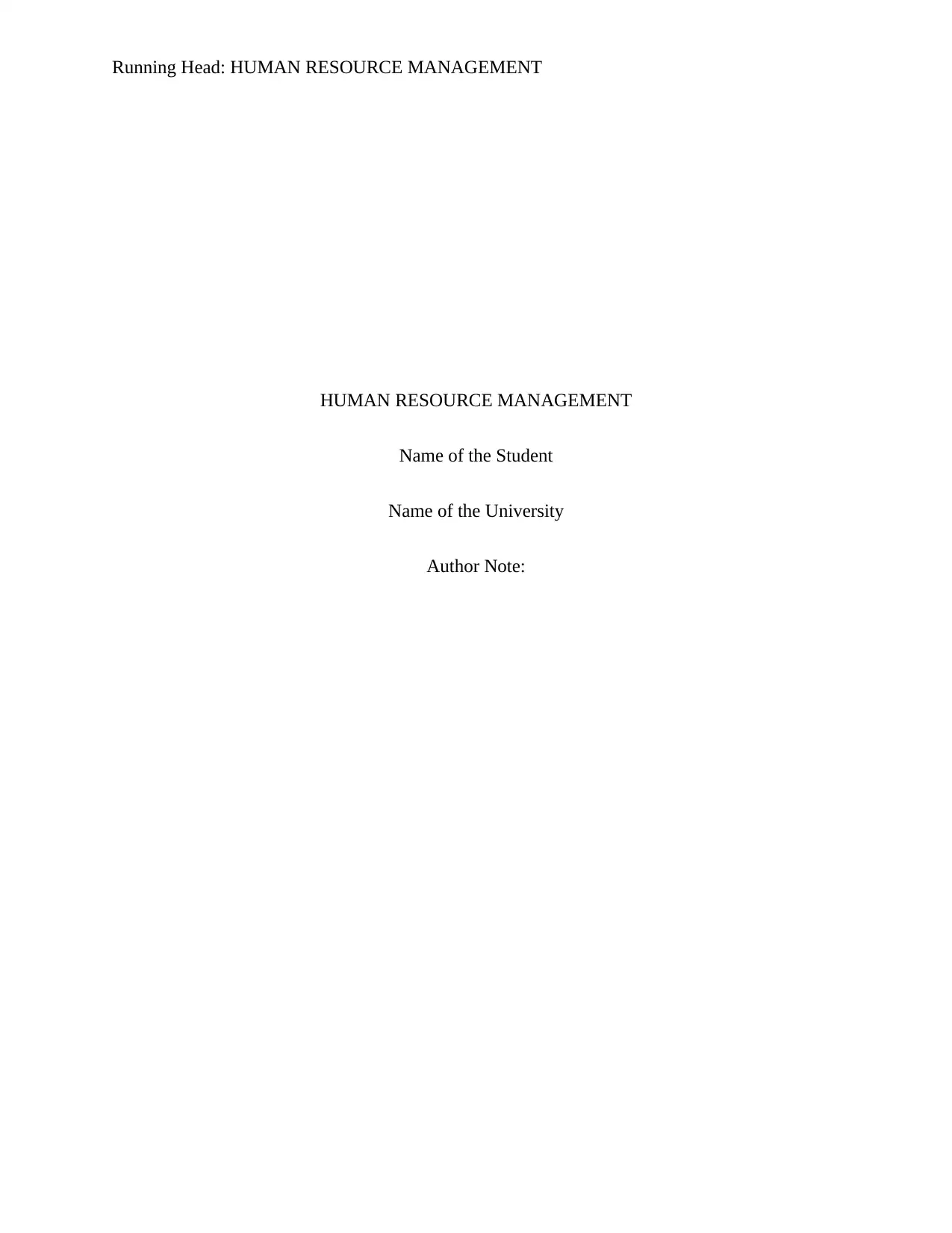
Running Head: HUMAN RESOURCE MANAGEMENT
HUMAN RESOURCE MANAGEMENT
Name of the Student
Name of the University
Author Note:
HUMAN RESOURCE MANAGEMENT
Name of the Student
Name of the University
Author Note:
Paraphrase This Document
Need a fresh take? Get an instant paraphrase of this document with our AI Paraphraser
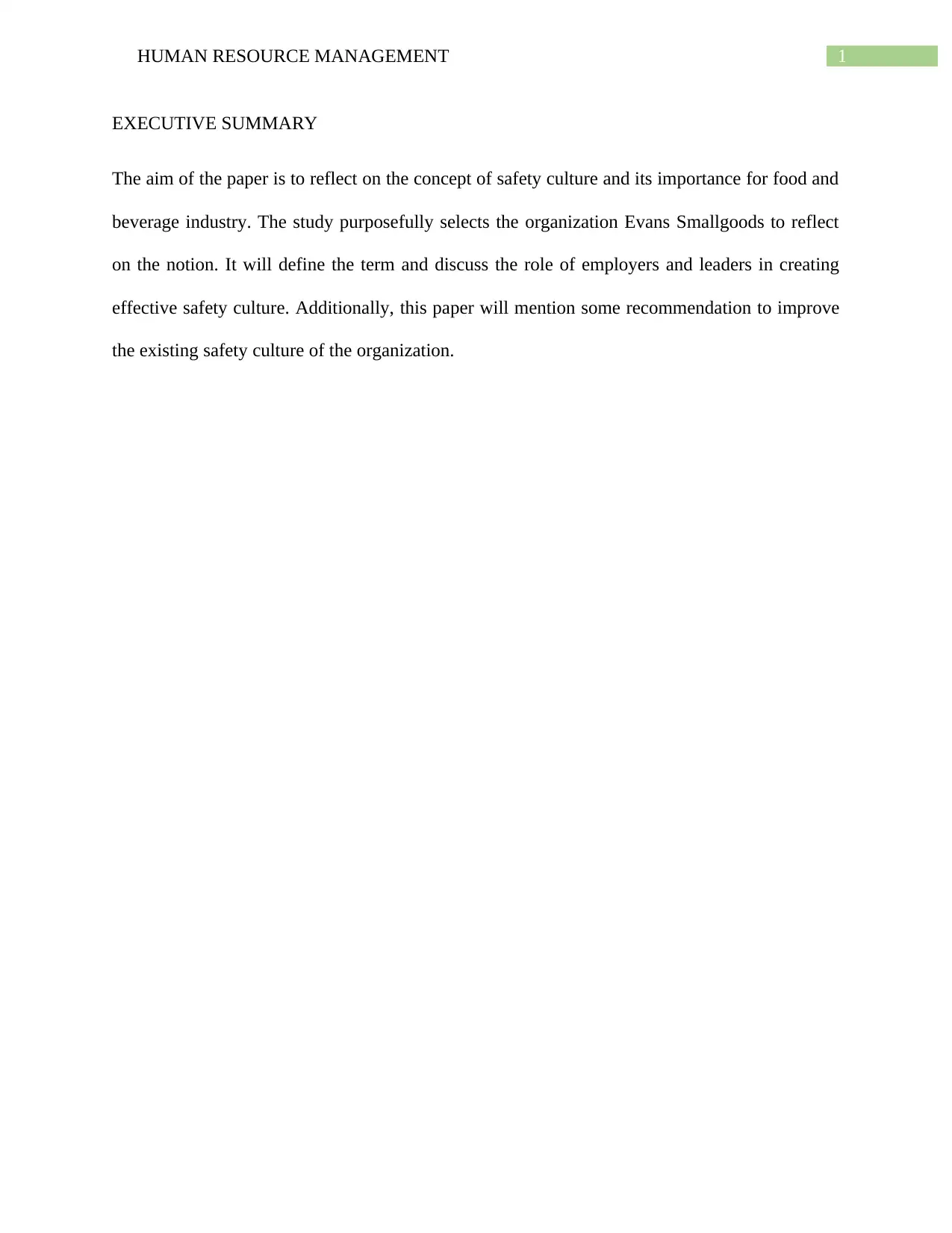
1HUMAN RESOURCE MANAGEMENT
EXECUTIVE SUMMARY
The aim of the paper is to reflect on the concept of safety culture and its importance for food and
beverage industry. The study purposefully selects the organization Evans Smallgoods to reflect
on the notion. It will define the term and discuss the role of employers and leaders in creating
effective safety culture. Additionally, this paper will mention some recommendation to improve
the existing safety culture of the organization.
EXECUTIVE SUMMARY
The aim of the paper is to reflect on the concept of safety culture and its importance for food and
beverage industry. The study purposefully selects the organization Evans Smallgoods to reflect
on the notion. It will define the term and discuss the role of employers and leaders in creating
effective safety culture. Additionally, this paper will mention some recommendation to improve
the existing safety culture of the organization.
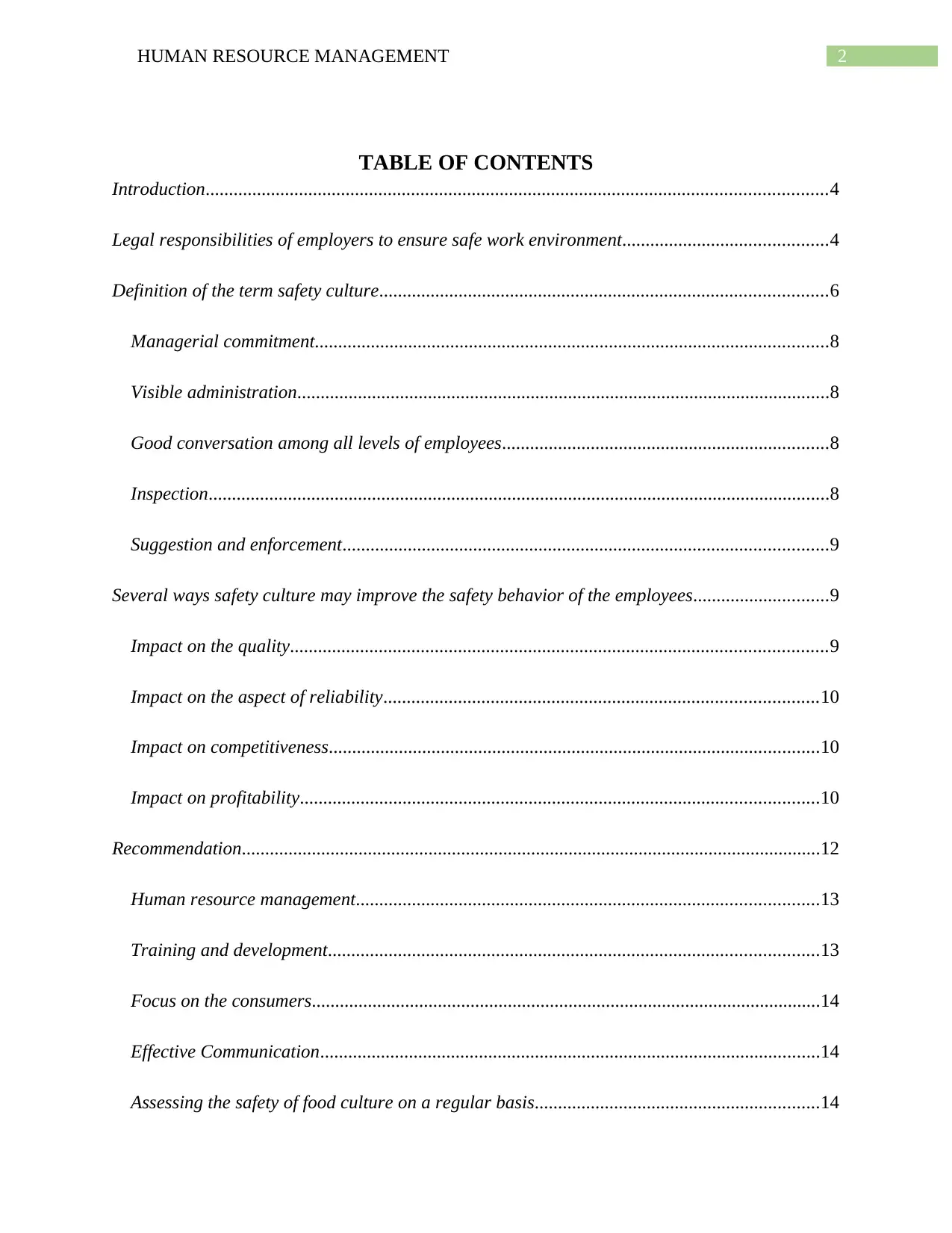
2HUMAN RESOURCE MANAGEMENT
TABLE OF CONTENTS
Introduction.....................................................................................................................................4
Legal responsibilities of employers to ensure safe work environment............................................4
Definition of the term safety culture................................................................................................6
Managerial commitment..............................................................................................................8
Visible administration..................................................................................................................8
Good conversation among all levels of employees......................................................................8
Inspection.....................................................................................................................................8
Suggestion and enforcement........................................................................................................9
Several ways safety culture may improve the safety behavior of the employees.............................9
Impact on the quality...................................................................................................................9
Impact on the aspect of reliability.............................................................................................10
Impact on competitiveness.........................................................................................................10
Impact on profitability...............................................................................................................10
Recommendation............................................................................................................................12
Human resource management...................................................................................................13
Training and development.........................................................................................................13
Focus on the consumers.............................................................................................................14
Effective Communication...........................................................................................................14
Assessing the safety of food culture on a regular basis.............................................................14
TABLE OF CONTENTS
Introduction.....................................................................................................................................4
Legal responsibilities of employers to ensure safe work environment............................................4
Definition of the term safety culture................................................................................................6
Managerial commitment..............................................................................................................8
Visible administration..................................................................................................................8
Good conversation among all levels of employees......................................................................8
Inspection.....................................................................................................................................8
Suggestion and enforcement........................................................................................................9
Several ways safety culture may improve the safety behavior of the employees.............................9
Impact on the quality...................................................................................................................9
Impact on the aspect of reliability.............................................................................................10
Impact on competitiveness.........................................................................................................10
Impact on profitability...............................................................................................................10
Recommendation............................................................................................................................12
Human resource management...................................................................................................13
Training and development.........................................................................................................13
Focus on the consumers.............................................................................................................14
Effective Communication...........................................................................................................14
Assessing the safety of food culture on a regular basis.............................................................14
⊘ This is a preview!⊘
Do you want full access?
Subscribe today to unlock all pages.

Trusted by 1+ million students worldwide
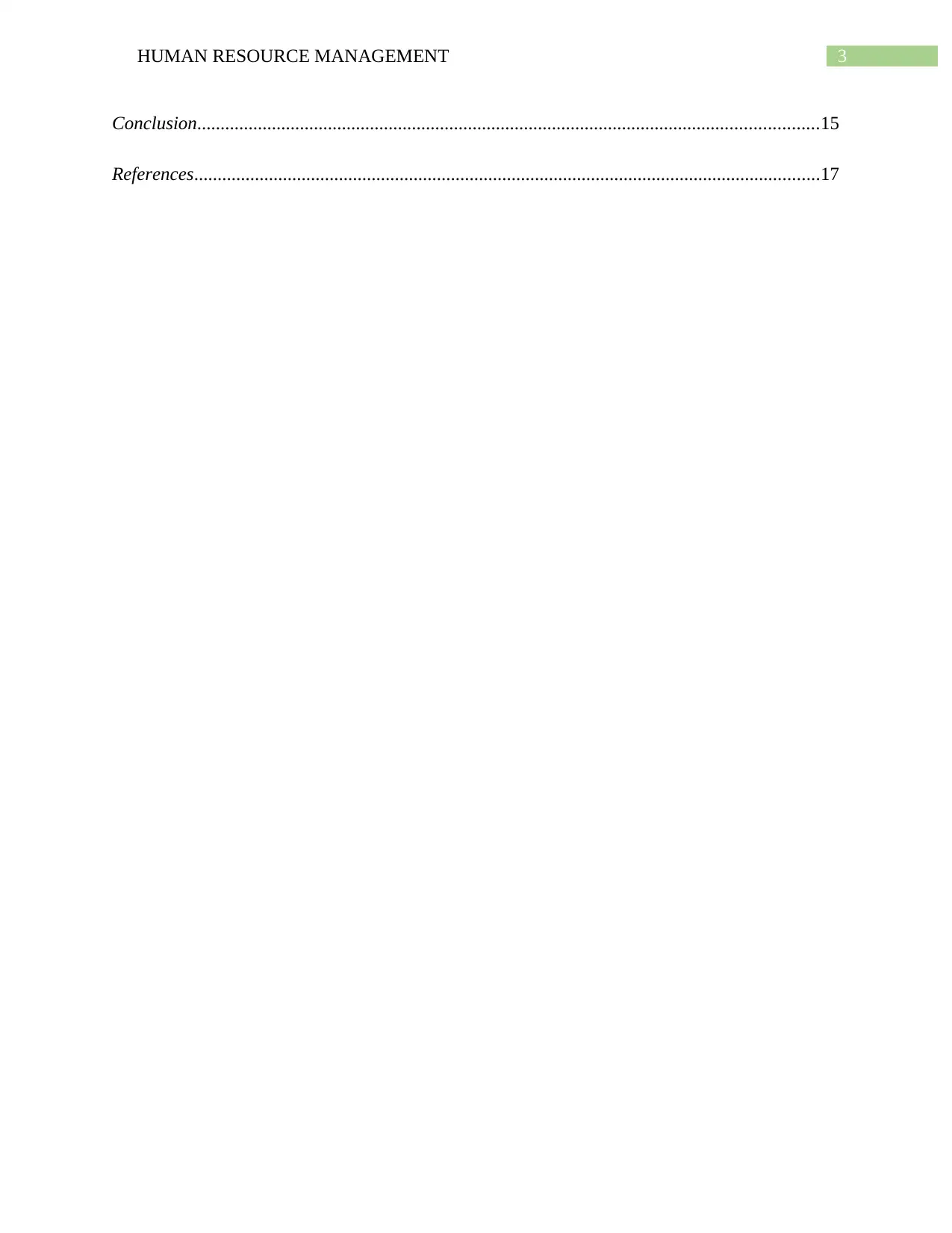
3HUMAN RESOURCE MANAGEMENT
Conclusion.....................................................................................................................................15
References......................................................................................................................................17
Conclusion.....................................................................................................................................15
References......................................................................................................................................17
Paraphrase This Document
Need a fresh take? Get an instant paraphrase of this document with our AI Paraphraser
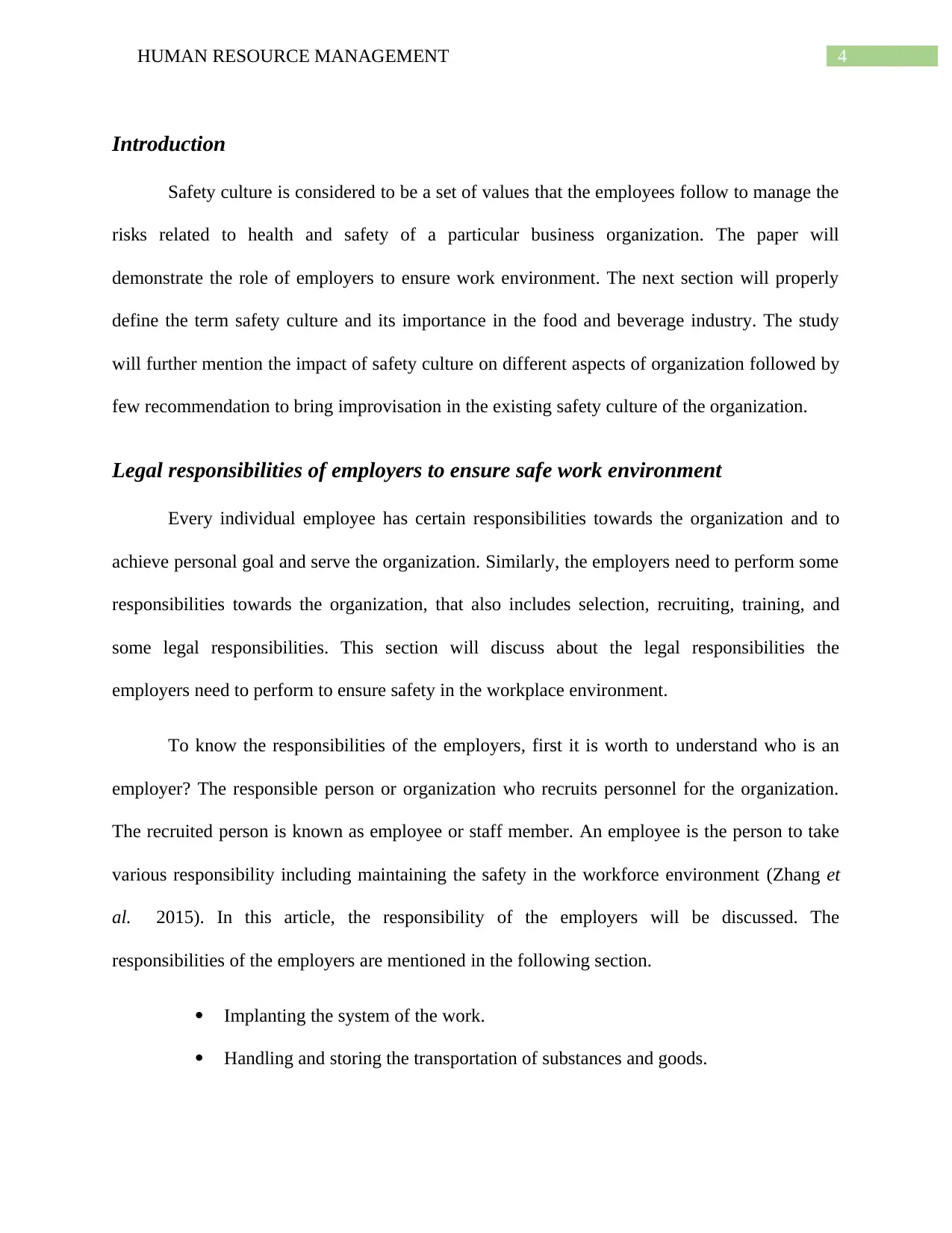
4HUMAN RESOURCE MANAGEMENT
Introduction
Safety culture is considered to be a set of values that the employees follow to manage the
risks related to health and safety of a particular business organization. The paper will
demonstrate the role of employers to ensure work environment. The next section will properly
define the term safety culture and its importance in the food and beverage industry. The study
will further mention the impact of safety culture on different aspects of organization followed by
few recommendation to bring improvisation in the existing safety culture of the organization.
Legal responsibilities of employers to ensure safe work environment
Every individual employee has certain responsibilities towards the organization and to
achieve personal goal and serve the organization. Similarly, the employers need to perform some
responsibilities towards the organization, that also includes selection, recruiting, training, and
some legal responsibilities. This section will discuss about the legal responsibilities the
employers need to perform to ensure safety in the workplace environment.
To know the responsibilities of the employers, first it is worth to understand who is an
employer? The responsible person or organization who recruits personnel for the organization.
The recruited person is known as employee or staff member. An employee is the person to take
various responsibility including maintaining the safety in the workforce environment (Zhang et
al. 2015). In this article, the responsibility of the employers will be discussed. The
responsibilities of the employers are mentioned in the following section.
Implanting the system of the work.
Handling and storing the transportation of substances and goods.
Introduction
Safety culture is considered to be a set of values that the employees follow to manage the
risks related to health and safety of a particular business organization. The paper will
demonstrate the role of employers to ensure work environment. The next section will properly
define the term safety culture and its importance in the food and beverage industry. The study
will further mention the impact of safety culture on different aspects of organization followed by
few recommendation to bring improvisation in the existing safety culture of the organization.
Legal responsibilities of employers to ensure safe work environment
Every individual employee has certain responsibilities towards the organization and to
achieve personal goal and serve the organization. Similarly, the employers need to perform some
responsibilities towards the organization, that also includes selection, recruiting, training, and
some legal responsibilities. This section will discuss about the legal responsibilities the
employers need to perform to ensure safety in the workplace environment.
To know the responsibilities of the employers, first it is worth to understand who is an
employer? The responsible person or organization who recruits personnel for the organization.
The recruited person is known as employee or staff member. An employee is the person to take
various responsibility including maintaining the safety in the workforce environment (Zhang et
al. 2015). In this article, the responsibility of the employers will be discussed. The
responsibilities of the employers are mentioned in the following section.
Implanting the system of the work.
Handling and storing the transportation of substances and goods.

5HUMAN RESOURCE MANAGEMENT
Providing information or instruction and often supervision to monitor the health
and safety culture of the workforce environment.
Maintaining the safety related to the entrance and exit of the organization.
Providing and maintaining the safety in the environment with ample amount of
facilities (Hopkins 2017).
Employers having more than five members working under the supervision must
have written policy for the safety facilities.
The other most important responsibility of an employer is to look after the other
employees using the same premise for the work.
Employers are also true and legal worker of the organization. There are several aspects included
in the right of an employer. These aspects are mentioned in the following section.
Regulation of knowledge about health and safety – It is the primary piece of
legislation made by every organization. As an additional facility, specific
regulation of awareness in the leading field and construction of the work (Weaver
et al. 2013).
Assessing the risk – The employers’ responsibility for the business organization
also include assessing the probable risk of the particular organization. Assessing
the risks refer to identification of the probable problems that can bring any
negative circumstances for the business organization.
According to the business law and management, employers need to look after the
health and safety of the management team. Employers must perform the needful
activities to achieve success.
Providing information or instruction and often supervision to monitor the health
and safety culture of the workforce environment.
Maintaining the safety related to the entrance and exit of the organization.
Providing and maintaining the safety in the environment with ample amount of
facilities (Hopkins 2017).
Employers having more than five members working under the supervision must
have written policy for the safety facilities.
The other most important responsibility of an employer is to look after the other
employees using the same premise for the work.
Employers are also true and legal worker of the organization. There are several aspects included
in the right of an employer. These aspects are mentioned in the following section.
Regulation of knowledge about health and safety – It is the primary piece of
legislation made by every organization. As an additional facility, specific
regulation of awareness in the leading field and construction of the work (Weaver
et al. 2013).
Assessing the risk – The employers’ responsibility for the business organization
also include assessing the probable risk of the particular organization. Assessing
the risks refer to identification of the probable problems that can bring any
negative circumstances for the business organization.
According to the business law and management, employers need to look after the
health and safety of the management team. Employers must perform the needful
activities to achieve success.
⊘ This is a preview!⊘
Do you want full access?
Subscribe today to unlock all pages.

Trusted by 1+ million students worldwide
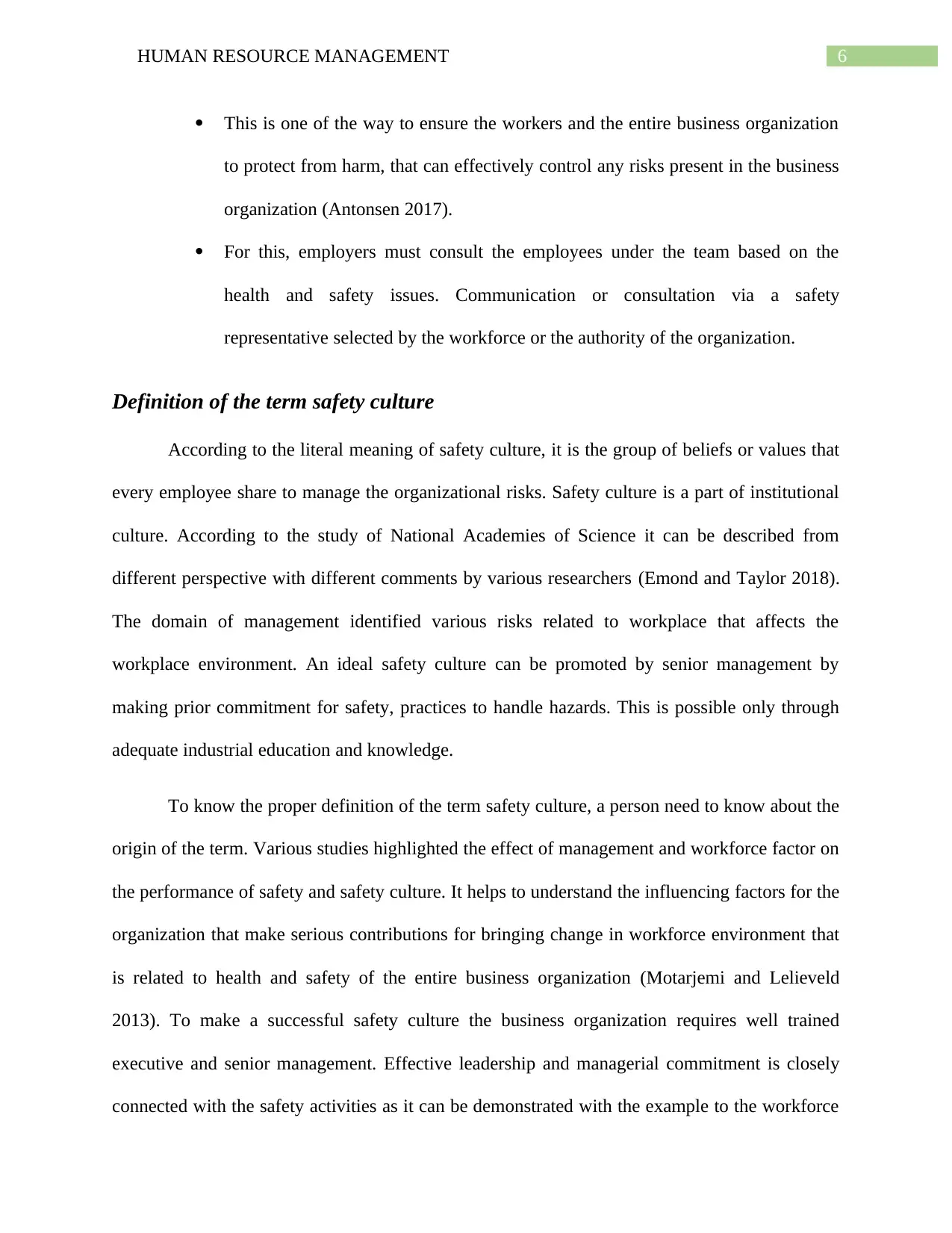
6HUMAN RESOURCE MANAGEMENT
This is one of the way to ensure the workers and the entire business organization
to protect from harm, that can effectively control any risks present in the business
organization (Antonsen 2017).
For this, employers must consult the employees under the team based on the
health and safety issues. Communication or consultation via a safety
representative selected by the workforce or the authority of the organization.
Definition of the term safety culture
According to the literal meaning of safety culture, it is the group of beliefs or values that
every employee share to manage the organizational risks. Safety culture is a part of institutional
culture. According to the study of National Academies of Science it can be described from
different perspective with different comments by various researchers (Emond and Taylor 2018).
The domain of management identified various risks related to workplace that affects the
workplace environment. An ideal safety culture can be promoted by senior management by
making prior commitment for safety, practices to handle hazards. This is possible only through
adequate industrial education and knowledge.
To know the proper definition of the term safety culture, a person need to know about the
origin of the term. Various studies highlighted the effect of management and workforce factor on
the performance of safety and safety culture. It helps to understand the influencing factors for the
organization that make serious contributions for bringing change in workforce environment that
is related to health and safety of the entire business organization (Motarjemi and Lelieveld
2013). To make a successful safety culture the business organization requires well trained
executive and senior management. Effective leadership and managerial commitment is closely
connected with the safety activities as it can be demonstrated with the example to the workforce
This is one of the way to ensure the workers and the entire business organization
to protect from harm, that can effectively control any risks present in the business
organization (Antonsen 2017).
For this, employers must consult the employees under the team based on the
health and safety issues. Communication or consultation via a safety
representative selected by the workforce or the authority of the organization.
Definition of the term safety culture
According to the literal meaning of safety culture, it is the group of beliefs or values that
every employee share to manage the organizational risks. Safety culture is a part of institutional
culture. According to the study of National Academies of Science it can be described from
different perspective with different comments by various researchers (Emond and Taylor 2018).
The domain of management identified various risks related to workplace that affects the
workplace environment. An ideal safety culture can be promoted by senior management by
making prior commitment for safety, practices to handle hazards. This is possible only through
adequate industrial education and knowledge.
To know the proper definition of the term safety culture, a person need to know about the
origin of the term. Various studies highlighted the effect of management and workforce factor on
the performance of safety and safety culture. It helps to understand the influencing factors for the
organization that make serious contributions for bringing change in workforce environment that
is related to health and safety of the entire business organization (Motarjemi and Lelieveld
2013). To make a successful safety culture the business organization requires well trained
executive and senior management. Effective leadership and managerial commitment is closely
connected with the safety activities as it can be demonstrated with the example to the workforce
Paraphrase This Document
Need a fresh take? Get an instant paraphrase of this document with our AI Paraphraser

7HUMAN RESOURCE MANAGEMENT
about the activities those will be rewarded or penalized. This system will influence the
behavioral features of the employees and maintain a healthy workforce culture.
Hence, as a definition it can be said that, safety culture is a managerial customs that
positions an extreme significance on safety beliefs, attitude and principles – and these are
transmitted by the common section of community within the business or administrative center. It
can be featured as the way employees perform the activities around the organization (Cunha et
al. 2014). An ideal safety culture can be responsible to improve the workplace health and safety
and managerial performance. The following section will mention the responsibility of a leader to
maintain proper safety culture in the business organization.
Define the importance of safety for the organization.
Differing the importance of safety most of the time or all the time (Zhang et al. 2015).
Defining the value of maintaining safety culture inside the organization.
The framework of safety culture has demonstrated some activities to be considered as the
activities related to maintain safety for the business organization. The activities are mentioned in
the following section.
Communication about the value of the organization.
Description of the leadership.
Providing clarification for the required behavior.
Customize the outcomes of the safety activities.
Development of positive attitude for safety (De Boeck et al. 2015).
Providing own safety responsibilities.
Increasing the behavior to maintain the risks or hazards.
about the activities those will be rewarded or penalized. This system will influence the
behavioral features of the employees and maintain a healthy workforce culture.
Hence, as a definition it can be said that, safety culture is a managerial customs that
positions an extreme significance on safety beliefs, attitude and principles – and these are
transmitted by the common section of community within the business or administrative center. It
can be featured as the way employees perform the activities around the organization (Cunha et
al. 2014). An ideal safety culture can be responsible to improve the workplace health and safety
and managerial performance. The following section will mention the responsibility of a leader to
maintain proper safety culture in the business organization.
Define the importance of safety for the organization.
Differing the importance of safety most of the time or all the time (Zhang et al. 2015).
Defining the value of maintaining safety culture inside the organization.
The framework of safety culture has demonstrated some activities to be considered as the
activities related to maintain safety for the business organization. The activities are mentioned in
the following section.
Communication about the value of the organization.
Description of the leadership.
Providing clarification for the required behavior.
Customize the outcomes of the safety activities.
Development of positive attitude for safety (De Boeck et al. 2015).
Providing own safety responsibilities.
Increasing the behavior to maintain the risks or hazards.

8HUMAN RESOURCE MANAGEMENT
Improving the knowledge sharing procedure to ensure the management system.
Reflection of the implementation of safety culture on the work environment.
The following section will discuss about the main aspects of effective safety culture.
Managerial commitment – this aspect refers to the commitment that produces extreme
motivation and concern related to health and safety through various activities in the organization.
The proportion of resources including the time, audience, and capital, are the indicators to
support the allocated health and safety maintenance of the organization. This activity requires
active performance of the senior managers of the business organization (Powell et al. 2013).
Visible administration – for this aspect, the managers need to possess good amount of
knowledge about workplace safety culture. According to the study, an ideal leader maintains a
good communication with the members of the front desk staff members. It is an important aspect
that a manager must perceive to maintain the committed safety for the business organization.
Good conversation among all levels of employees – In an effective safety culture
communication is a healthy practice among all level of staff members of the business
organization. The leaders must listen to the employees working under their supervision to make
the safety culture an effective one (Guo, Goh and Wong 2018).
Inspection – This is also a crucial part of implementing safety culture in the workforce
environment. Inspection involves various processes including interviewing the significant cross-
sections of the business organization. The question answer sessions are helpful for the activity
called inspection and also for the entire procedure of safety culture.
Improving the knowledge sharing procedure to ensure the management system.
Reflection of the implementation of safety culture on the work environment.
The following section will discuss about the main aspects of effective safety culture.
Managerial commitment – this aspect refers to the commitment that produces extreme
motivation and concern related to health and safety through various activities in the organization.
The proportion of resources including the time, audience, and capital, are the indicators to
support the allocated health and safety maintenance of the organization. This activity requires
active performance of the senior managers of the business organization (Powell et al. 2013).
Visible administration – for this aspect, the managers need to possess good amount of
knowledge about workplace safety culture. According to the study, an ideal leader maintains a
good communication with the members of the front desk staff members. It is an important aspect
that a manager must perceive to maintain the committed safety for the business organization.
Good conversation among all levels of employees – In an effective safety culture
communication is a healthy practice among all level of staff members of the business
organization. The leaders must listen to the employees working under their supervision to make
the safety culture an effective one (Guo, Goh and Wong 2018).
Inspection – This is also a crucial part of implementing safety culture in the workforce
environment. Inspection involves various processes including interviewing the significant cross-
sections of the business organization. The question answer sessions are helpful for the activity
called inspection and also for the entire procedure of safety culture.
⊘ This is a preview!⊘
Do you want full access?
Subscribe today to unlock all pages.

Trusted by 1+ million students worldwide
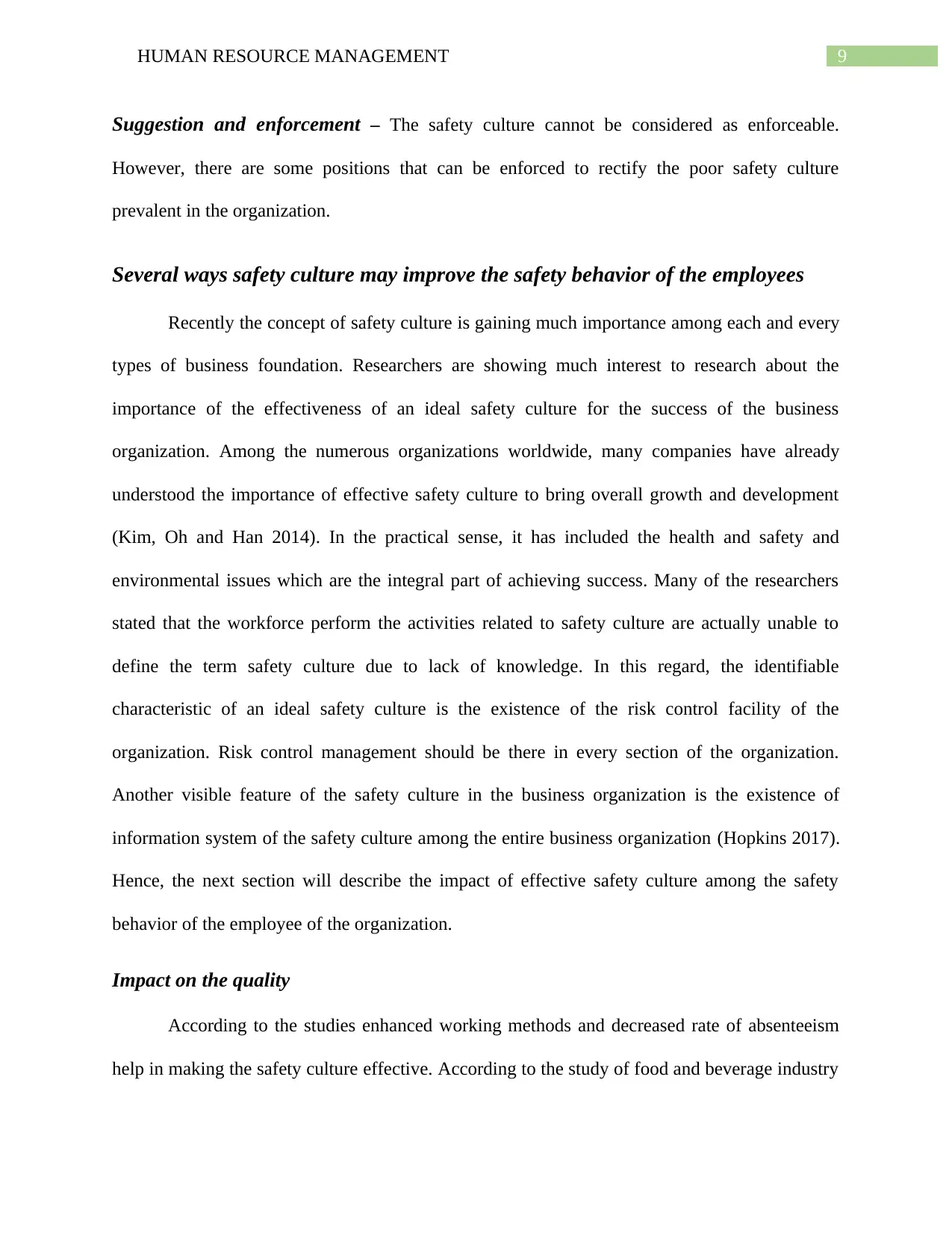
9HUMAN RESOURCE MANAGEMENT
Suggestion and enforcement – The safety culture cannot be considered as enforceable.
However, there are some positions that can be enforced to rectify the poor safety culture
prevalent in the organization.
Several ways safety culture may improve the safety behavior of the employees
Recently the concept of safety culture is gaining much importance among each and every
types of business foundation. Researchers are showing much interest to research about the
importance of the effectiveness of an ideal safety culture for the success of the business
organization. Among the numerous organizations worldwide, many companies have already
understood the importance of effective safety culture to bring overall growth and development
(Kim, Oh and Han 2014). In the practical sense, it has included the health and safety and
environmental issues which are the integral part of achieving success. Many of the researchers
stated that the workforce perform the activities related to safety culture are actually unable to
define the term safety culture due to lack of knowledge. In this regard, the identifiable
characteristic of an ideal safety culture is the existence of the risk control facility of the
organization. Risk control management should be there in every section of the organization.
Another visible feature of the safety culture in the business organization is the existence of
information system of the safety culture among the entire business organization (Hopkins 2017).
Hence, the next section will describe the impact of effective safety culture among the safety
behavior of the employee of the organization.
Impact on the quality
According to the studies enhanced working methods and decreased rate of absenteeism
help in making the safety culture effective. According to the study of food and beverage industry
Suggestion and enforcement – The safety culture cannot be considered as enforceable.
However, there are some positions that can be enforced to rectify the poor safety culture
prevalent in the organization.
Several ways safety culture may improve the safety behavior of the employees
Recently the concept of safety culture is gaining much importance among each and every
types of business foundation. Researchers are showing much interest to research about the
importance of the effectiveness of an ideal safety culture for the success of the business
organization. Among the numerous organizations worldwide, many companies have already
understood the importance of effective safety culture to bring overall growth and development
(Kim, Oh and Han 2014). In the practical sense, it has included the health and safety and
environmental issues which are the integral part of achieving success. Many of the researchers
stated that the workforce perform the activities related to safety culture are actually unable to
define the term safety culture due to lack of knowledge. In this regard, the identifiable
characteristic of an ideal safety culture is the existence of the risk control facility of the
organization. Risk control management should be there in every section of the organization.
Another visible feature of the safety culture in the business organization is the existence of
information system of the safety culture among the entire business organization (Hopkins 2017).
Hence, the next section will describe the impact of effective safety culture among the safety
behavior of the employee of the organization.
Impact on the quality
According to the studies enhanced working methods and decreased rate of absenteeism
help in making the safety culture effective. According to the study of food and beverage industry
Paraphrase This Document
Need a fresh take? Get an instant paraphrase of this document with our AI Paraphraser
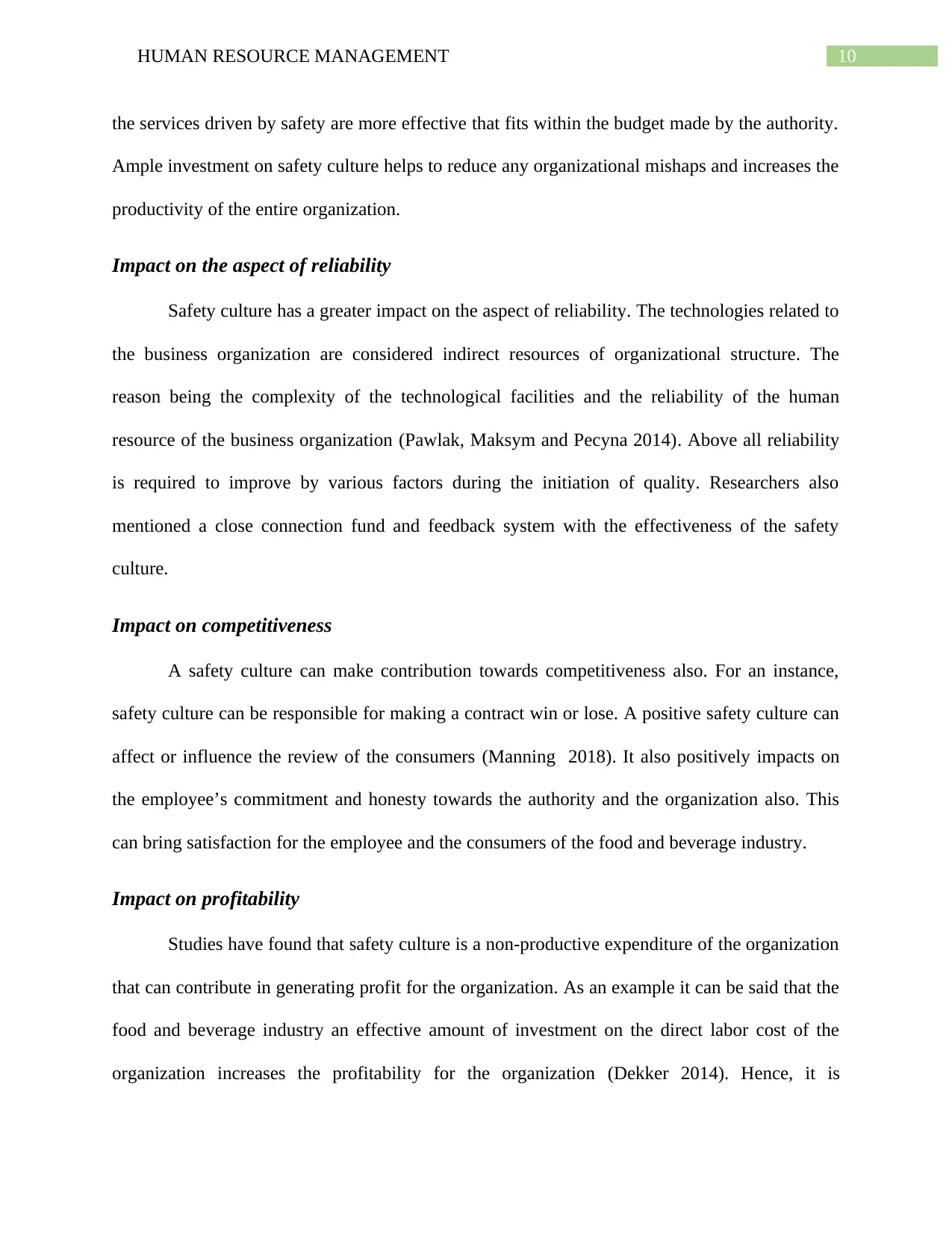
10HUMAN RESOURCE MANAGEMENT
the services driven by safety are more effective that fits within the budget made by the authority.
Ample investment on safety culture helps to reduce any organizational mishaps and increases the
productivity of the entire organization.
Impact on the aspect of reliability
Safety culture has a greater impact on the aspect of reliability. The technologies related to
the business organization are considered indirect resources of organizational structure. The
reason being the complexity of the technological facilities and the reliability of the human
resource of the business organization (Pawlak, Maksym and Pecyna 2014). Above all reliability
is required to improve by various factors during the initiation of quality. Researchers also
mentioned a close connection fund and feedback system with the effectiveness of the safety
culture.
Impact on competitiveness
A safety culture can make contribution towards competitiveness also. For an instance,
safety culture can be responsible for making a contract win or lose. A positive safety culture can
affect or influence the review of the consumers (Manning 2018). It also positively impacts on
the employee’s commitment and honesty towards the authority and the organization also. This
can bring satisfaction for the employee and the consumers of the food and beverage industry.
Impact on profitability
Studies have found that safety culture is a non-productive expenditure of the organization
that can contribute in generating profit for the organization. As an example it can be said that the
food and beverage industry an effective amount of investment on the direct labor cost of the
organization increases the profitability for the organization (Dekker 2014). Hence, it is
the services driven by safety are more effective that fits within the budget made by the authority.
Ample investment on safety culture helps to reduce any organizational mishaps and increases the
productivity of the entire organization.
Impact on the aspect of reliability
Safety culture has a greater impact on the aspect of reliability. The technologies related to
the business organization are considered indirect resources of organizational structure. The
reason being the complexity of the technological facilities and the reliability of the human
resource of the business organization (Pawlak, Maksym and Pecyna 2014). Above all reliability
is required to improve by various factors during the initiation of quality. Researchers also
mentioned a close connection fund and feedback system with the effectiveness of the safety
culture.
Impact on competitiveness
A safety culture can make contribution towards competitiveness also. For an instance,
safety culture can be responsible for making a contract win or lose. A positive safety culture can
affect or influence the review of the consumers (Manning 2018). It also positively impacts on
the employee’s commitment and honesty towards the authority and the organization also. This
can bring satisfaction for the employee and the consumers of the food and beverage industry.
Impact on profitability
Studies have found that safety culture is a non-productive expenditure of the organization
that can contribute in generating profit for the organization. As an example it can be said that the
food and beverage industry an effective amount of investment on the direct labor cost of the
organization increases the profitability for the organization (Dekker 2014). Hence, it is
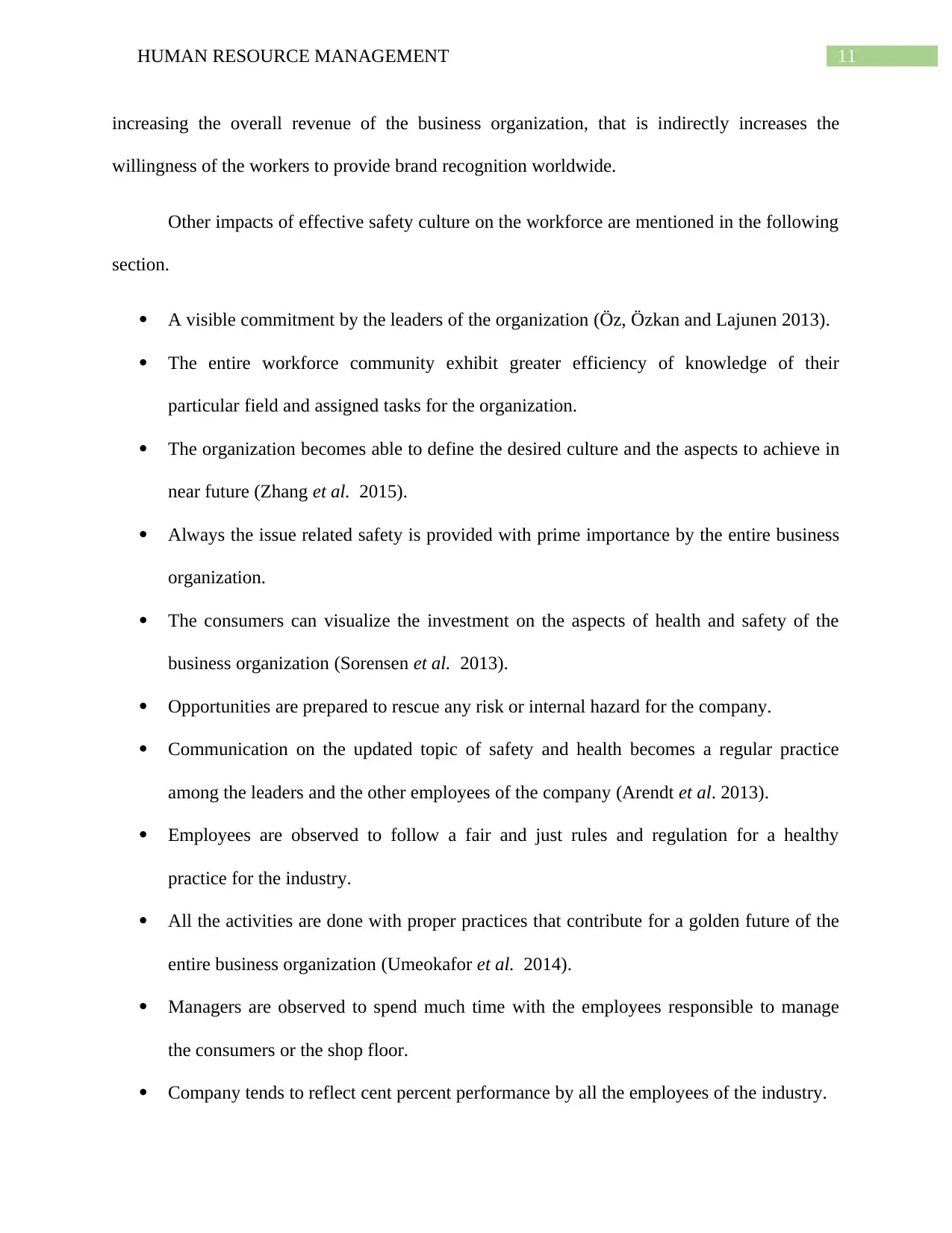
11HUMAN RESOURCE MANAGEMENT
increasing the overall revenue of the business organization, that is indirectly increases the
willingness of the workers to provide brand recognition worldwide.
Other impacts of effective safety culture on the workforce are mentioned in the following
section.
A visible commitment by the leaders of the organization (Öz, Özkan and Lajunen 2013).
The entire workforce community exhibit greater efficiency of knowledge of their
particular field and assigned tasks for the organization.
The organization becomes able to define the desired culture and the aspects to achieve in
near future (Zhang et al. 2015).
Always the issue related safety is provided with prime importance by the entire business
organization.
The consumers can visualize the investment on the aspects of health and safety of the
business organization (Sorensen et al. 2013).
Opportunities are prepared to rescue any risk or internal hazard for the company.
Communication on the updated topic of safety and health becomes a regular practice
among the leaders and the other employees of the company (Arendt et al. 2013).
Employees are observed to follow a fair and just rules and regulation for a healthy
practice for the industry.
All the activities are done with proper practices that contribute for a golden future of the
entire business organization (Umeokafor et al. 2014).
Managers are observed to spend much time with the employees responsible to manage
the consumers or the shop floor.
Company tends to reflect cent percent performance by all the employees of the industry.
increasing the overall revenue of the business organization, that is indirectly increases the
willingness of the workers to provide brand recognition worldwide.
Other impacts of effective safety culture on the workforce are mentioned in the following
section.
A visible commitment by the leaders of the organization (Öz, Özkan and Lajunen 2013).
The entire workforce community exhibit greater efficiency of knowledge of their
particular field and assigned tasks for the organization.
The organization becomes able to define the desired culture and the aspects to achieve in
near future (Zhang et al. 2015).
Always the issue related safety is provided with prime importance by the entire business
organization.
The consumers can visualize the investment on the aspects of health and safety of the
business organization (Sorensen et al. 2013).
Opportunities are prepared to rescue any risk or internal hazard for the company.
Communication on the updated topic of safety and health becomes a regular practice
among the leaders and the other employees of the company (Arendt et al. 2013).
Employees are observed to follow a fair and just rules and regulation for a healthy
practice for the industry.
All the activities are done with proper practices that contribute for a golden future of the
entire business organization (Umeokafor et al. 2014).
Managers are observed to spend much time with the employees responsible to manage
the consumers or the shop floor.
Company tends to reflect cent percent performance by all the employees of the industry.
⊘ This is a preview!⊘
Do you want full access?
Subscribe today to unlock all pages.

Trusted by 1+ million students worldwide
1 out of 21
Related Documents
Your All-in-One AI-Powered Toolkit for Academic Success.
+13062052269
info@desklib.com
Available 24*7 on WhatsApp / Email
![[object Object]](/_next/static/media/star-bottom.7253800d.svg)
Unlock your academic potential
Copyright © 2020–2025 A2Z Services. All Rights Reserved. Developed and managed by ZUCOL.




